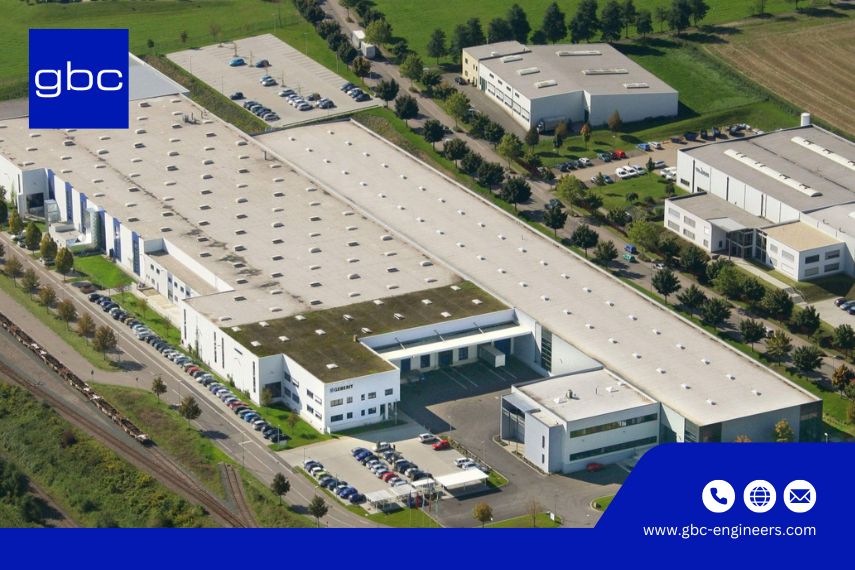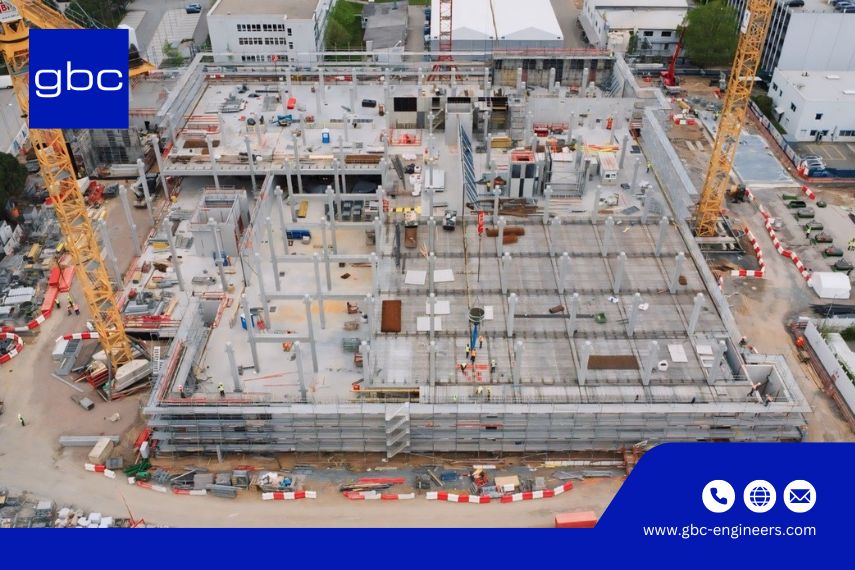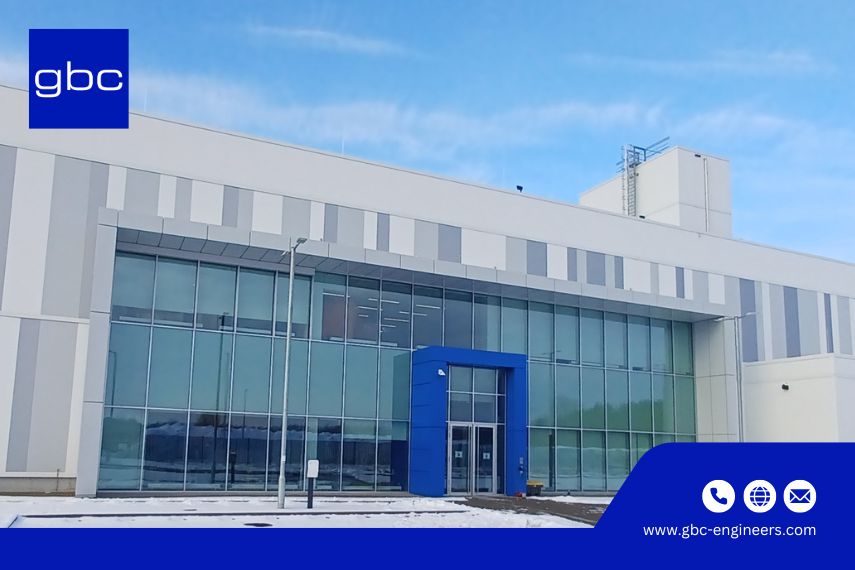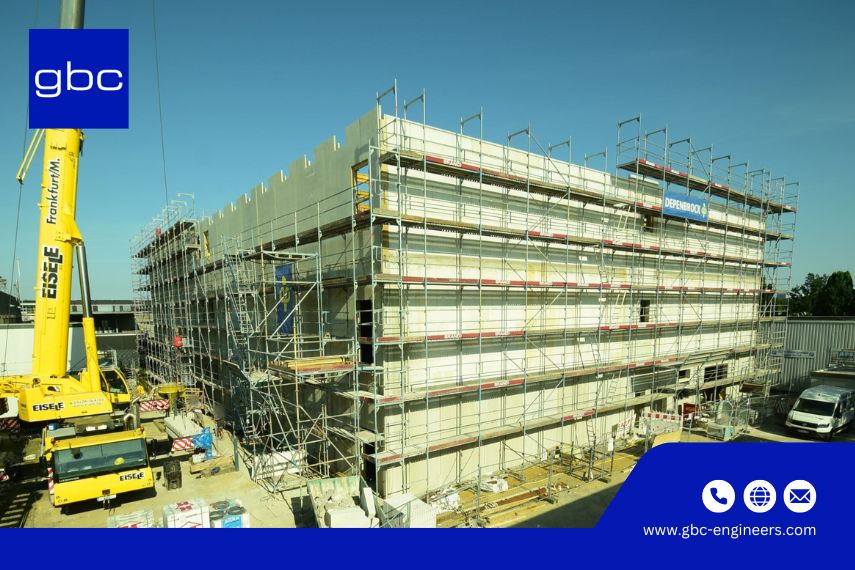Introduction
Across Europe, data centers have become the backbone of the digital economy. Every online transaction, AI query, or cloud service request depends on these highly engineered facilities. As demand for hyperscale capacity grows to support artificial intelligence, high-performance computing, and cloud infrastructure, the structural design of data centers is entering a new era of complexity and innovation.
Modern data centers are no longer simple industrial buildings. They are critical assets that must combine reliability, scalability, and sustainability in one structural system. Each facility needs to carry heavier loads, enable faster construction, integrate advanced cooling systems, and comply with increasingly strict environmental requirements.
For engineering consultancies across Europe, these evolving demands call for a new mindset. Structural design must work hand in hand with mechanical, electrical, and environmental systems to achieve both performance and efficiency. At gbc engineers, this integration defines every stage of our approach, from digital modeling and value engineering to sustainable material selection and fast-track execution.
The transformation of structural engineering in data center projects marks a decisive step toward smarter, stronger, and more sustainable digital infrastructure across Europe.

Why Structural Design Must Evolve for Hyperscale Data Centers
In today’s digital era, hyperscale data centers are no longer just large warehouses to store servers, they represent complex, mission-critical infrastructure that requires a fundamentally different structural approach. For operators and developers across Europe, understanding why structural design must evolve is essential to meeting the demands of scalability, performance, sustainability and resilience.
From Traditional Buildings to Mission-Critical Infrastructure
Traditionally, commercial or industrial buildings were designed with predictable loads, moderate spans, and straightforward mechanical systems. In contrast, modern hyperscale data centers impose radically different demands: extremely high point loads, complex mechanical, electrical and plumbing (MEP) systems, continuous operations, and fast-track delivery timelines. According to gbc engineers, “Optimizing construction costs while enhancing seismic resilience and operational efficiency is at the core of our data center design strategy.”
Key Drivers of Change
Here are the main factors pushing the structural design of data centers into a new realm:
- Heavy-load scenarios: Server racks, battery banks, large UPS systems, chillers and rooftop equipment all add significant weight. Designs must address heavy load structural engineering for data centers to ensure floors, slabs and foundations can support these demands without excessive settlement or deflection.
- Speed and modularity: The market demands rapid delivery and scaling up of facilities. Consequently, modular data center structural design and prefabricated elements are becoming the norm, which drives structural designers to rethink traditional construction sequences and structural systems.
- Mechanical/thermal integration: Large cooling systems, liquid cooling, HVAC modules and energetic equipment often sit on roofs or mezzanines. Their loads, vibrations, and interaction with structure cannot be treated as afterthoughts — the structural concept must integrate these cooling systems’ impact on structure.
- Resilience and compliance: With clients requiring minimal downtime and high reliability, structural design must incorporate seismic resilient data center structures, vibration control, and meet rigorous standards (e.g., DIN/EN, Tier classifications).
- Sustainability: Operating costs, embodied carbon, efficiency and lifecycle value matter. Structural engineers now play an active role in sustainable structural design for data centers - selecting materials, optimizing spans/columns, reducing embedded emissions.
- European/Local context: In markets like Germany, France or the Nordics, site conditions (soil, climate, regulation) add complexity. Data center structural design in Germany/Europe therefore requires local code knowledge, familiarity with snow loads, frost penetration, and cost pressures specific to the region.
Implications for Design Teams and Owners
For project owners and engineering teams, these changes mean:
- Structural engineers must engage from very early project stages (site selection, feasibility, load modelling) rather than being a late discipline
- Workflows must integrate digital tools (BIM, structural simulation, value engineering) to optimise structure, cost and schedule
- Coordination with MEP, power, cooling and architectural teams becomes essential — structural design can no longer operate in silos
- Ownership of lifecycle performance means structural systems should allow for future expansion, flexibility, modular upgrades, and lower operational risk
At gbc engineers, our expertise in data center structural engineering spans full-spectrum service delivery: from foundation and geotechnical engineering through BIM-led structural modelling to construction supervision.
By evolving structural design to meet these new demands, hyperscale data centers in Europe become not only viable and efficient, but strategic assets that deliver long-term performance, sustainability and return on investment.
10 Key Structural Design Trends
Europe’s data center market is expanding at record speed, driven by artificial intelligence, high-performance computing, and the growing demand for cloud infrastructure. This evolution has changed what structural engineering must deliver. From load capacity to sustainability and modularity, the following trends are defining the next generation of hyperscale data centers.
Heavy-Load Design for AI and High-Density Racks
The rise of AI and high-density servers has significantly increased structural loads. Floors and foundations must now support thousands of kilograms per square meter.
Engineers use advanced analysis and data center structural design principles to minimize deflection and vibration while maintaining cost efficiency. In projects such as FRA31 Data Center, load simulations and vibration models ensured long-term stability under full rack occupancy.

Modular and Prefabricated Structural Solutions
Speed and scalability have made modular construction the new standard. Prefabricated elements, including precast concrete walls and steel platforms, shorten on-site assembly and improve quality control.
This method was successfully applied in the BER22 Data Center, where modular units allowed simultaneous installation of structural and MEP systems. Prefabrication not only accelerates delivery but also supports replication of standardized designs across Europe.
Foundation and Substructure Optimization
European sites vary widely, from soft clay in the Netherlands to dense rock in southern Germany. Effective data center foundation design considers soil bearing capacity, groundwater, and frost levels.
Solutions may include raft slabs, pile systems, or vibration isolation. By integrating geotechnical and structural modeling early in design, engineers achieve long-term stability and reduced settlement. Similar strategies were applied in FR13 Data Center to optimize the foundation for high loads and challenging subsoil conditions.
Seismic and Structural Resilience
Hyperscale data centers must remain operational under all circumstances. Reinforced concrete cores, braced steel frames, and isolation bearings improve resilience against external and internal vibrations.
The BER14 Data Center showcases how resilient design principles safeguard critical infrastructure, ensuring minimal downtime and maximum structural reliability.

Integrating Cooling and Mechanical Systems into the Structure
Cooling equipment often contributes significant dynamic loads, especially when installed on roofs or mezzanines. Structural engineers now integrate mechanical and cooling considerations from the earliest design stage.
This interdisciplinary coordination, supported by BIM-driven collaboration, allows engineers to anticipate deflection, vibration, and reinforcement needs before construction begins.
Sustainable Structural Design for Data Centers
Sustainability is now an essential design requirement. Low-carbon concrete, recycled steel, and efficient composite systems reduce embodied carbon while maintaining strength.
In the FRA3 Data Center, structural optimization through digital modeling reduced material use without compromising performance. These methods align with the European Green Deal and modern ESG standards.
Fast-Track and Accelerated Construction
Delivering data centers faster is crucial to staying competitive. Fast-track design integrates planning, fabrication, and installation in parallel.
Standardized reference designs enable replication across major hubs like Berlin, Frankfurt, and Hamburg. This approach was refined through industrial and infrastructure projects where BIM coordination and modular detailing shortened timelines without compromising safety or compliance.
Structural Solutions for Hyperscale Facilities
Large-scale facilities require flexibility and strength. Engineers use wide column grids, long spans, and post-tensioned slabs to accommodate heavy IT zones and adaptable layouts.
In projects such as FR10 Data Center, clear spans of over 18 meters were achieved using composite beams and high-strength materials, supporting both current and future generations of hardware.
Retrofitting and Upgrading Existing Buildings
Redeveloping industrial buildings into data centers is increasingly common in dense urban zones. Retrofitting requires careful assessment of floor capacity, vibration resistance, and structural reinforcement.
Existing facilities are strengthened through additional framing, secondary beams, and upgraded load paths. The Penta HAM01 Data Center demonstrates how structural retrofits can transform existing assets into high-performance digital hubs.

Adapting to European Climate and Regulatory Context
Every European region presents its own climate and regulatory challenges. Data center structural design in Germany and Europe must consider snow loads, frost depth, and DIN/EN standards.
In the Renewal of Railway Overpass Niederbiegen, site-specific weather conditions shaped foundation and waterproofing solutions, a principle equally critical in data center design for northern climates.
These ten trends highlight how structural engineering is redefining the way data centers are designed, built, and operated. From FRA31 Frankfurt to BER22 Berlin, each project demonstrates how innovation, sustainability, and precision create resilient digital infrastructure for Europe’s future.
The gbc engineers Approach to Structural Design of Data Centers
At gbc engineers, structural design for data centers combines digital precision, sustainable thinking, and international collaboration. Each project is engineered to meet the complex requirements of hyperscale infrastructure while maintaining efficiency, resilience, and long-term value.
Integrated Design and Digital Collaboration
Every project begins with a clear understanding of structural and operational goals. Through BIM-driven coordination, our teams integrate structural, mechanical, and electrical systems in a single model, minimizing conflicts and ensuring seamless execution.
By connecting geotechnical expertise, foundation optimization, and structural analysis, we create solutions that perform reliably under heavy loads and demanding operational conditions.
Value Engineering and Sustainability
Efficiency and sustainability are inseparable parts of our design philosophy. Through value engineering, we optimize materials, simplify construction processes, and lower embodied carbon. Whether applying hybrid steel–concrete systems or modular prefabrication, the goal is always to achieve maximum performance with minimal environmental impact.
Our approach aligns with the European Green Deal and ESG targets that increasingly shape the data center sector.
Global Expertise, Local Execution
With teams in Germany, Poland, and Vietnam, gbc engineers connects international standards with local know-how. This cross-border collaboration allows projects to progress continuously across time zones, ensuring compliance with European standards such as DIN and EN while meeting the fast-track demands of global clients.
Quality and Reliability
Every project follows a transparent three-step QA process that includes self-check, peer review, and final approval. The workflow is managed through our digital Odoo-based system to ensure full traceability, compliance with Eurocodes, and consistent quality throughout all design phases.
Our experience in data center projects shows how precision, accountability, and well-structured quality control translate into durable and scalable structures.
Building Europe’s Digital Future
Through its integrated design philosophy, commitment to sustainability, and digital expertise, gbc engineers is shaping the next generation of data center structural design in Europe. Each structure reflects our mission: to build smarter, faster, and stronger foundations for the continent’s expanding digital infrastructure.
Conclusion
The structural design of data centers is evolving faster than ever, shaped by the combined forces of digitalization, sustainability, and global connectivity. Across Europe, the next generation of hyperscale facilities is being defined not only by their capacity but by how intelligently and efficiently they are built.
At gbc engineers, structural engineering is more than a technical service. It forms the foundation of resilient digital infrastructure. By integrating BIM-driven design, value engineering principles, and sustainable material strategies, we create solutions that achieve the right balance between performance, cost efficiency, and environmental responsibility.
From foundation and geotechnical design to modular prefabrication and seismic analysis, every project reflects a commitment to reliability and long-term value. Our multidisciplinary teams in Germany, Poland, and Vietnam collaborate seamlessly to design and deliver data centers that meet the rigorous demands of hyperscale operations while supporting Europe’s transition to a sustainable digital economy.
As data centers continue to grow in scale and complexity, one principle remains constant: smart structural design is the backbone of digital progress.
|
About us
gbc engineers
is an international engineering consultancy with offices in Germany, Poland, and Vietnam, having delivered 10,000+ projects worldwide. We provide services in structural engineering, data center design, infrastructure and bridge engineering, BIM & Scan-to-BIM, and construction management. Combining German engineering quality with international expertise, we achieve sustainable, safe, and efficient solutions for our clients.
|